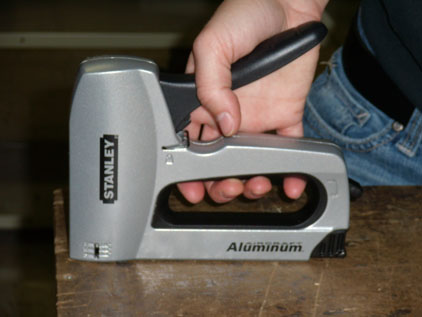Staple gun
From DDL Wiki
(→Dissection) |
|||
| Line 45: | Line 45: | ||
=Dissection= | =Dissection= | ||
| - | Procedure with pictures coming soon. Preview: | + | Procedure with pictures coming soon. Preview: http://picasaweb.google.com/kfalletta/StapleGun12407 |
=Documentation= | =Documentation= | ||
Revision as of 09:21, 31 January 2007
Contents |
Group 3
- Kristine Falletta
- Kacy Hess
- Galen Mullins
- Josh Schmieder
Product Dissection
The following notes were taken prior to and during product dissection.
Function/Purpose
The function of the product is to fasten materials together using staples. This product is meant to be used to hang items from surfaces (such as walls, ceilings, etc.), attach one item to another, and other similar actions. It can also be used to shoot stables at targets, though this is not an intended use.
Inputs/Outputs
In order to use the stable gun both a force and a material are needed. The staples must be properly loaded in the gun, after which the proper force must be applied to the handle (generally created by the squeezing of a hand). This results in a stable projectile (typically into a surface) and recoil from the handle.
Typical Use Scenario
1. Pick up the staple gun and placed hand on handle
2. Positioned material with empty hand against item to be fastened to
3. Positioned gun against the material
4. Squeezed handled to release staple
5. Removed gun and checked to see if the materials were fastened together
6. No staple is present so repeats steps 2-5
7. Locates reloading place for staples
8. Removes slider on bottom of gun to check for staples
9. When no staples are present, finds staples and attempts to insert them
10. Positions staples over extruded part of staple loader and tries to close gun
11. When the slider will not close, repositions staples inside gun and closes slider successfully
12. Repeats steps 2-5
13. Finds that staple has successfully attached the two materials
Note: May have to unlock staple gun or adjust staple power before use. Do not always have to insert new staples.
Intended Use/Limitations/Annoyances
As previously stated, the intended function of this product are to fasten materials together by shooting a staple through them. Other features that are used to enhance this function include the ability to lock the handle for more compact storage and/or safety reasons, adjustable power so that the user may staple with more or less force, as well as a loading mechanism. Staples may be loaded by sliding the bottom of the stapler out, inserting the staples into the open compartment, then sliding and locking the bottom of the stapler back in place. There are a number of limitations and annoyances with this design. With regards to typical use, a great amount of force is required to squeeze the handle for shooting staples. It is also difficult to adjust the power. Furthermore, it is difficult to stretch over a distance and still be able to exert enough force to squeeze the handle and press down on the surface. It is even more difficult to reach into small or tight places due to the size of and configuration of the staple gun. As for safety, there is no safety lock currently installed. Note that the lock that is already on the stapler is intended for storage purposes, and does not prevent the accidental trigger of the staple gun. Also, the size is awkward and difficult to store or carry when also using other tools. Some of the advantages of this design are its sturdiness and solid weight, the easy loading mechanism (once the process is known), the comfortable grip, and the availability of a power adjustment option (which also makes the product seem higher in quality/more advanced).
Different Users / Use Scenarios
There are some instances that may occur in which the user might find this product difficult to use. Should the force to dispense staples be too high, people with small or weak hands would not be able to use it. On the other end of the spectrum, people with large hands may not be able to fit their hands in the handle. Another scenerio that could occur is the desire to use the staple gun improperly (e.g. shooting staples at one another). Finally, people who need to fit staples in small, tight places may not be able to get the gun into those places.
Other Stakeholders
Identify other stakeholders besides the end user, such as those who manufacture, distribute, sell, purchase, assist, install, maintain, repair and manage the product's end of life. Document attributes of the product that affect these stakeholders.
Dissection
Procedure with pictures coming soon. Preview: http://picasaweb.google.com/kfalletta/StapleGun12407


















